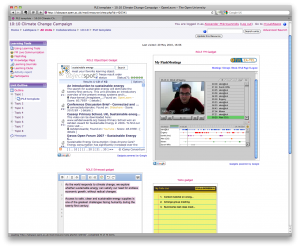The OpenLearn Test-bed
The objective of the OpenLearn test-bed is to offer learners a richer and more personalized experience, by implementing a transition towards the Personal Learning Environment (PLE) paradigm. This transition bears significant benefits for learners, as it puts emphasis to their needs and preferences, providing them with a wider choice of learning resources to choose from, both from internal as well as external sources.
The following screenshot shows a selection of ROLE gadgets embedded within an OpenLearn course. The learner is studying climate change and sustainable energy. She finds learning materials through the ObjectSpot search gadget (from OpenLearn, iTunesU, Wikipedia, SlideShare, and YouTube) and collaborates with other learners through the FlashMeeting and Etherpad gadgets. She also uses third-party gadgets, such as the To-do gadget to prioritise her learning tasks.
The transformation of the OpenLearn into a PLE is being driven by the following 3 key issues:
1. Tools and personalisation: The tools available in OpenLearn are generally not associated with any particular learning content. This can be improved by linking content with tools and allowing users to bring in their own tools, so that they personalise their learning environment and gain more control over the manipulation and production of content.
2. Collaborative learning: The learning content provided by OpenLearn is comprised of standalone units, which are generally not being studied in a social context. Despite the existence of some social tools within OpenLearn, there is still a gap in supporting collaborative learning. An improvement in this case is providing support to learners for fostering communities, aiming to a shared learning experience instead of a lone study.
3. Support for self-regulated learning: OpenLearn was originally built around units of study and not the personal profiles of learners; hence a learner-centric approach is missing. Learners do not get any guidance about how to learn on their own, neither from technology, nor from peers. There is therefore a lack of support for self-regulated learning and competency-based guidance for the learning journey. A formal user model is also missing; only the standard Moodle profile is used for all OpenLearn users.

